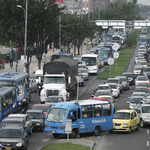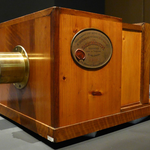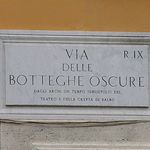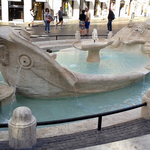Celio
The ancient name Mons Quequetulanus came from the oaks that were covering it. The name of Caelius would have been taken from the Etruscan leader named by Caelius Vibenna who had been settled down here before the hill was occupied by Rome and before Tullo Ostilio placed here the defeated Albani. Afterwards it became one of the most aristocratic quarters of l'Urbe. It had several temples and because of being close to the Palatine and to the Oppio hill,one of the three tops of Esquiline), it was occupied by the Neronian buildings. It continued to be important also in the High Middle Ages thanks to being close to the Lateran.
Fires and the sacks after the hold of Rome by Guiscardo Roberto(1084) completely devastated it. Since then the Caelius remained half-deserted with a few mostly religious buildings which are scattered between the green trees.
Today its appearance is rather changed.However it remains less inhabited and maybe the most striking of the Roman hills thanks to much grass and the churches of ancient tradition.
One of the streets of approach is the Via Claudia that passes along the impressive masonries in brick enlivened by niches belonging to the Claudio's Temple constructed by the order of Agrippina, mother of Nero.
She dedicated the temple to her second husband. Nero turned it into a ninfeo (a house ofa nimphaea) and Vespasian remade it again in a luxurious manner).
On the top of the hill Piazza della Navicella is situated.
It contains the elegant Fontana della Navicella made up according to the Roman marble ship's model . The fountain is placed on the pedestal adorned of the weapon and the name of Leon X (1513).
The boat is also a copy of some boat remained from ancient epoch of soldiers who had their quarter nearby (castra peregrina), It refers to the time of Leon X.
In the opposite the church of Santa Maria In Domenica is located which is constructed in the VIIth century on the remains of a Roman building of no importance. It was inlarged by Pasqual I in 817-24, renewed by the cardinal Giovanni de Medici in 1513 and later by Leon X and restored again in 1820. The name comes from the appelative dominicum given to the Christian cult places in the first centuries. The ordinary Renaissance façade is preceded by an elegant wide porch with arcades on pillars and lasene which are of Doric order and brings Bramante's inspiration created by Andrea Sansovino in 1513.
To the left of the church one can find the magnificent entry portal referred to the Cinquecento and coming from Villa Massimo which belongs to Villa Celimontana already Villa Mattei bought by the Mattei family in 1553 and subsequently occupied by the casino of Giacomo of the Duke during 1581-86. Nowadays it is a public park.
On the magnificent masonries mostly of the flavian age the villa covers all the western slopes of the Caelius with the luxuriant vegetation of conifers, palms, holm-aoks and laurels forming galleries.
At the end of the avenue facing the entry , on its left side the ancient Egyptian obelisk dedicated to Ramses II can be seen.
Earlier it was already placed on the right side of the Aracoeli Convent entry and it was presented to the Ciriaco Mattei by the Roman Senate in 1584.
It was him who ordered to put it up in this villa.
In the middle of the villa full of sculptures, statues, cippus (funeral or honorable signs), columns and other excavated marbles a seat of the Italian Geographic Association is located which was founded in Florence in 1867 and moved to Rome in 1872.
On the northern border near the secondary exit it is possible to see the sides of the Absidiola of the Church of San Tommaso in Formis with tiny windows. From here a rectilinear avenue leads to the monumental entry originally belonged to the villa of 1650.
It shows to Piazza Santi Giovanni e Paolo square where the homonymous basilica stands.
The Basilica of Saint-Giovanni and Paolo was accomplished in the house of two officers of the Constantine Court who were martyrized then by Giuliano l' Apostata. A few time after, about 398, the senator Bizante and his son Pammachio either a senator put up the basilica above the worshipped sanctuary of the two martyrs. So through the changes it has reached up us as a whole unit.Devastated in 410 by Alarico hordes it was consolidated as well as after the earthquake of 442 under Leon I and later after the sack of Roberto the Guiscardo in 1084.
In the time of Pasqual II (1099-1118) the cardinal Teobaldo rebuilt the contiguous convent and started constructing the bell tower which was finished in the second half of the XIIth century by the Cardinal Giovanni of Sutri. The current porch is owed to them built in the place of the ancient narthex. Restorations, alterations and additions were continued on in the next centuries up to 1715 when the cardinal Fabrizio Paolucci promoted the almost total internal transformation.
If to get down to the Via di San Gregorio that follows after the layout of the ancient Via Triumphalis, it was called so because of triumphal processions passed on here (The remains of Neronian acqueduct which was the branch of the Claudio acqueduct for to feed la Domus Aurea can be seen here) one arrives to the Piazza di Porta Capena.The square is a wide open space between the ramifications of the Caelius, the Palatine and Aventino.
On the right is the park of Circo Massimo and on the left is Terme di Caracalla.
In the opposite is the big and modern building where F.A.O. (Food And Agriculture Organization) is located.
In the center is the Axum Obelisk, 24 meters high dated by the IVth century. It was chosen among those ones which were in disposal in the saint city of Ethiopia and brought to Rome in 1937. Nowadays the Ethiopian govern has
claimed back the property.

 The records of Rome. Big numbers, not always enviable, for a big city.
The records of Rome. Big numbers, not always enviable, for a big city. New Phot-O-Matic section. To spend some time looking at photos (also) of Rome.
New Phot-O-Matic section. To spend some time looking at photos (also) of Rome. The administrative, urban, toponymic and imaginative subdivisions of Rome.
The administrative, urban, toponymic and imaginative subdivisions of Rome. Notice for tourists: in Rome you drink for free. Historical fountains and 'big noses'.
Notice for tourists: in Rome you drink for free. Historical fountains and 'big noses'. Free museums return on the first Sunday of the month.
Free museums return on the first Sunday of the month.